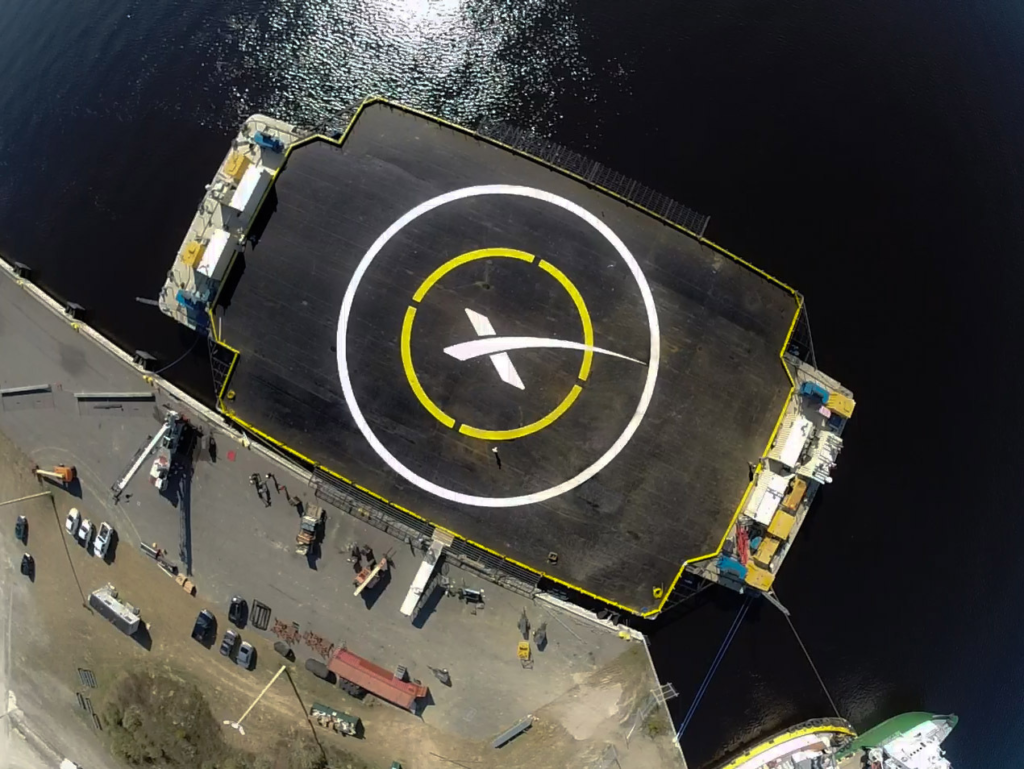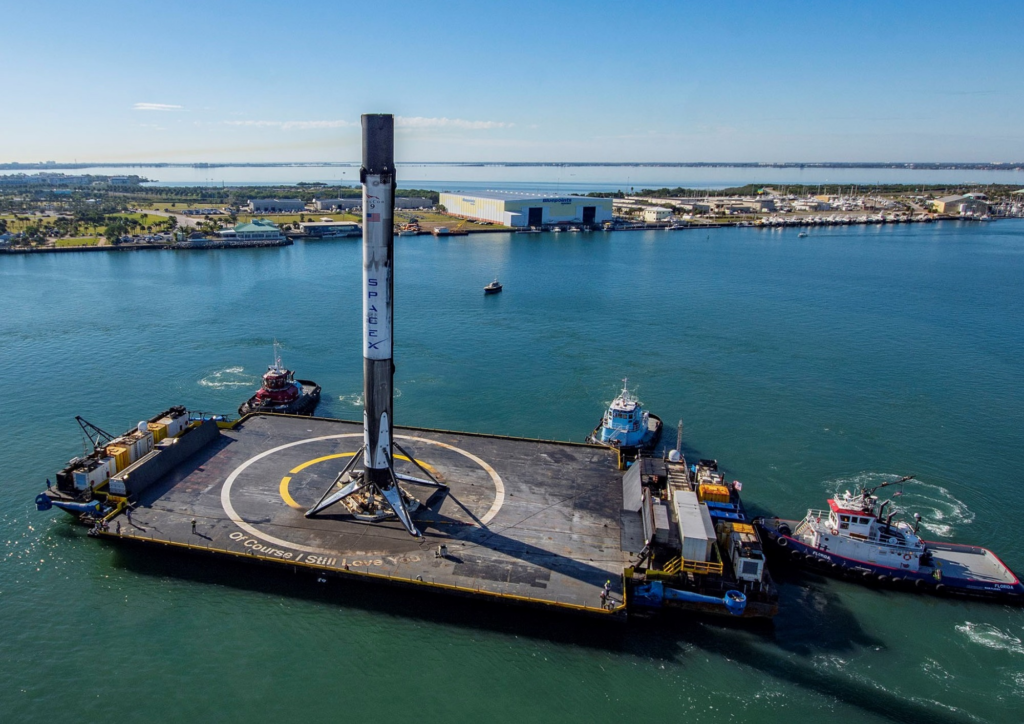Autonomous Spaceport Drone Ships (ASDS) are a groundbreaking innovation by SpaceX, designed to facilitate the recovery of rocket boosters at sea, particularly for the Falcon 9 rocket. These uncrewed sea barges play a crucial role in SpaceX’s mission to make space travel more affordable and sustainable by enabling the reuse of rocket components.
These floating landing pads are designed to recover rocket boosters after they’ve completed their mission of launching payloads into space. SpaceX, a leading aerospace company, has pioneered the development and use of ASDS, significantly advancing the prospects of reusable rocket technology.
Here are some key points about Autonomous Spaceport Drone Ships based on the provided search results:
Purpose, Design, Technical & Operational Aspects of Autonomous Spaceport Drone Ships (ASDS)
Purpose and Design: ASDS are ocean-going vessels equipped with station-keeping engines and large landing platforms. They autonomously position themselves for rocket landings, allowing SpaceX to recover the Falcon 9’s first stage, which is the most expensive part of the rocket.
Operational Details: SpaceX currently operates three ASDS: Just Read the Instructions (JRTI), A Shortfall of Gravitas (ASOG), and Of Course I Still Love You (OCISLY). These drone ships are strategically positioned in the Atlantic and Pacific oceans to support launches from various space centers.
Technical Composition: ASDS feature a dynamic positioning system for accurate location maintenance, robust landing pads to withstand rocket landings, and high-speed communication systems for real-time data transmission during missions.
Innovations: SpaceX has introduced grid fins for controlled descent and precision landing technology using advanced GPS systems to ensure accurate landings on the moving drone ships.
Impact and Implications: The use of ASDS has significantly reduced space launch costs by enabling the reuse of rocket components, leading to cost savings, reduced waste, and lower carbon emissions. This innovation has set new standards in space technology, inspiring future advancements in space exploration missions.
History of Autonomous Spaceport Drone Ships

Elon Musk articulated ambitions for reusable rockets in 2009, leading to the development of ASDS. The first drone ship used was the McDonough Marine Service’s Marmac 300 barge in December 2014. Since then, SpaceX has made significant progress in perfecting the technology and achieving successful landings on these autonomous platforms.
The concept of ASDS traces back to SpaceX’s early endeavors in the 2010s to develop a reusable rocket system. In 2014, SpaceX made its first attempt to land a rocket booster on a floating platform in the ocean, marking the initial steps towards the ASDS concept. After several unsuccessful attempts, SpaceX achieved its first successful landing on an ASDS in April 2016. Since then, the company has made significant progress in perfecting the technology, successfully recovering numerous rocket boosters.
The utilization of Autonomous Spaceport Drone Ships represents a paradigm shift in space exploration, making it more economically viable and environmentally sustainable. SpaceX’s innovative approach with ASDS has not only revolutionized rocket recovery but has also paved the way for future advancements in space technology and exploration missions.
Types & Quantity of Autonomous Spaceport Drone Ships (ASDS) does SpaceX have

SpaceX currently operates three Autonomous Spaceport Drone Ships (ASDS) for rocket recovery missions:
- Just Read the Instructions (JRTI): Operates in the Atlantic for launches from Kennedy Space Center and Cape Canaveral.
- A Shortfall of Gravitas (ASOG): Also operates in the Atlantic for launches from Kennedy Space Center and Cape Canaveral. ASOG is known for its ability to autonomously sail.
- Of Course I Still Love You (OCISLY): Operates in the Pacific to support missions from Vandenberg Space Force Base.
Also Read, World’s First Successful Hydrogen Combustion Test On Large Marine Ship Engine Achieved
Technology Behind Autonomous Spaceport Drone Ships
ASDS are equipped with advanced navigation systems, thrusters, and landing pads that enable them to autonomously position themselves in the ocean and recover rocket boosters. The navigation system uses GPS and other sensors to accurately position the platform, while the thrusters help maintain its position despite ocean currents.
The landing pads are designed to provide a stable surface for rockets to land on, with shock-absorbing materials to cushion the impact of landing.
Operations of Autonomous Spaceport Drone Ships

The operation of an ASDS begins with mission planning, where the mission control team selects a landing site based on the rocket’s trajectory. After the rocket launches and delivers its payload, the first stage of the rocket begins its descent back to Earth.
The ASDS autonomously positions itself in the ocean and communicates with the rocket to ensure a successful landing. Once the rocket lands on the ASDS, it is secured in place, and the platform is towed back to port for offloading.
Also Read, Everything about Diving Support Vessel? Explained
Advantages of Using Autonomous Spaceport Drone Ships
The use of ASDS offers several advantages over traditional rocket recovery methods. One of the primary advantages is cost reduction, as reusing rocket boosters significantly lowers the cost of launching payloads into space.
Additionally, ASDS enable more frequent and rapid rocket launches, as the time and resources required for rocket recovery are reduced. Moreover, the use of ASDS contributes to the sustainability of space exploration by reducing the environmental impact of rocket launches.
Challenges and Limitations
Despite their advantages, ASDS also face several challenges and limitations. One of the main challenges is the harsh environment of the ocean, which can damage the platform and affect its operations.
Additionally, the recovery and refurbishment of rocket boosters require significant time and resources, which can limit the scalability of the technology. Furthermore, the autonomous nature of ASDS raises safety concerns, as any malfunction could lead to the loss of the rocket and payload.
Future Prospects of Autonomous Spaceport Drone Ships
The future of ASDS looks promising, with ongoing efforts to enhance their capabilities and efficiency. SpaceX and other aerospace companies are continually innovating to make ASDS more autonomous, reliable, and cost-effective.
One of the key areas of development is increasing the payload capacity of ASDS to recover other components of the rocket, such as the fairings or the second stage. Additionally, advancements in AI and robotics are expected to further improve the efficiency and safety of ASDS operations.
Autonomous Spaceport Drone Ships have revolutionized the space industry by enabling the recovery and reuse of rocket boosters. SpaceX’s pioneering efforts in developing and using ASDS have paved the way for more sustainable and cost-effective space exploration.
Despite facing challenges and limitations, ASDS continue to evolve, offering exciting prospects for the future of space technology.
FAQs
- How do Autonomous Spaceport Drone Ships contribute to cost reduction in space exploration? Autonomous Spaceport Drone Ships enable the recovery and reuse of rocket boosters, significantly lowering the cost of launching payloads into space. By reusing rocket boosters, space exploration becomes more cost-effective and sustainable.
- What are the primary technologies used in Autonomous Spaceport Drone Ships?Autonomous Spaceport Drone Ships are equipped with advanced navigation systems, thrusters, and landing pads. The navigation system uses GPS and other sensors to accurately position the platform, while the thrusters help maintain its position in the ocean. The landing pads provide a stable surface for rockets to land on, with shock-absorbing materials to cushion the impact of landing.
- What are the main challenges faced by Autonomous Spaceport Drone Ships?Autonomous Spaceport Drone Ships face challenges such as the harsh environment of the ocean, which can damage the platform and affect its operations. The recovery and refurbishment of rocket boosters also require significant time and resources, limiting the scalability of the technology. Additionally, the autonomous nature of ASDS raises safety concerns, as any malfunction could lead to the loss of the rocket and payload.
- How are Autonomous Spaceport Drone Ships expected to evolve in the future?The future of Autonomous Spaceport Drone Ships looks promising, with ongoing efforts to enhance their capabilities and efficiency. SpaceX and other aerospace companies are working to make ASDS more autonomous, reliable, and cost-effective. Advancements in AI and robotics are expected to further improve the efficiency and safety of ASDS operations.
- What role do Autonomous Spaceport Drone Ships play in the sustainability of space exploration?Autonomous Spaceport Drone Ships play a crucial role in the sustainability of space exploration by enabling the recovery and reuse of rocket boosters. By reusing rocket boosters, space exploration becomes more environmentally friendly and cost-effective, reducing the need for new rocket components for each launch.

